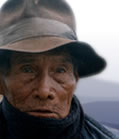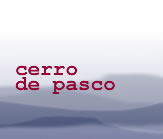THEMES IN THIS
TESTIMONY
Communications

Development

Education

Employment and Income

Environment

Health

History

Spiritual Beliefs

Click on arrows
to find more
testimonies
featuring
these themes
|
|
Sex
|
male
|
|
|
Age
|
40s
|
|
|
Occupation
|
teacher
|
|
|
Location
|
La Oroya
|
|
|
Date
|
1995
|
|
summary
Alejandro is from Yauli but lives in Oroya. He comes from a very united single parent family. He has great affection for his father, a miner, who brought up all the children alone. Alejandro studied as a secondary teacher but chose to work in a state primary school. He is very aware of class differences and the role of the mining company in inhibiting public action on pollution and the environment. He describes the two-tier school system: fee-paying company schools and state schools. Those attending private schools have many advantages, though these and other company social expenditures are ending with privatisation. He gives a first-hand account of a serious mining accident and the callous attitude of the company towards the bereaved families. He discusses the need for in-depth environmental studies on impact of pollution and economic alternatives, the limited impact of current environmental initiatives and the role of the company in stifling public action. There is some description and analysis of local myths and beliefs highlighting moral values and taboos eg incest. He also talks about cultural diversity as a result of the immigrant communities in Oroya.
detailed breakdown
|
You will need a password from Panos to view the full
transcript of the interview. To apply for a password, click here.
Once you have a password, click here to go to the beginning
of the transcript. You can also click on any section of the
breakdown of content below and go straight to the
corresponding part of the transcript.
|
| Section 1 |
Alejandro came to La Oroya through a job transfer
He grew up in Yauli as his father worked there (in mine), used to come to Oroya every weekend. Housing in Oroya scarce and expensive. Mother died, aunt helped out father to bring up the three children.
|
| Section 2 |
Story of major mining accident - many dead. The mining company deceived mourners, sending coffins with trunks inside instead of bodies.
Father told him that the miners used to chew coca, especially at night, so could keep going and not to get sleepy.
“Father also told us about the Muqui. It's a little dwarf who likes to play with children…. It's a mythical way of explaining what mining life is like, with its worries and dreams of good-fortune.”
|
| Section 3 |
Tells some stories: encounters with “the condemned people” (“who haven't been able to die in peace because they have caused a lot of harm in their lives”); and the ccalcareas legend - deals with incest. Might be told in relation to real events, a sort of social censure of bad behaviour , in a town where all knows all. He quotes the saying: "...small town, big hell..."
Moved to Ticlio, known for the passenger train crossing which is the highest in the Andes (4,850m). People would get soroche (altitude sickness)
|
| Section 4 |
“My dad was the breadwinner and the truth is we lived in constant fear that one day the bad news of an accident would come,” so eventually father left mine Two-tier education system in Oroya - company's private schools had huge advantages over state system. Only mine workers were in company schools. Changing now with privatisation; all schools will be in the state system.
|
| Section 5 |
His teaching approach builds on his knowledge of local community and people's experience
Description of lifestyle of gringos (North Americans who ran/owned the mines) in old company. Golf course, picnics etc.
With nationalisation, the golf course becomes municipal property. People don't look after it now, but feels it could be a park providing fresh(er) air
Remembers the old company store and its imported goods, now sadly missed by local population, especially the toys
|
| Section 6 |
Pollution from foundry affects everyone - respiratory, stomach and teeth problems. Some not very successful environmental conservation work done in schools eg reforestation programmes, but needs mass education approach: “we don't get any further in having a serious, comprehensive study of the issue which would cover education in the home to ensure the success of the anti-pollution campaigns and prevention. We have to find a way of getting over the overwhelming sense of resignation here.”
Local authorities don't react as depend on goodwill of Centromin
|
| Section 7 |
Pessimistic about development alternatives for Oroya - better in rural areas.
Possibly industry linked to foundry by-products, also cutting out the middle men in cattle/meat industry. Cites example of success of Cerro de Pasco Corporation
Privatisation of foundry: company off-loading social services onto state sector. New owners will only have to worry about production. Cut staff by half. Closure of foundry would be disastrous, not only for Oroya but whole regional economy.
Cites the example of once-prosperous Tinjahuaro, which became a ruined ghost town a few years after the foundry closed down.
|
| Section 8 |
Two stories of origin of name of Oroya. Mixed local culture from all the immigrants - seen in local festivities, surnames, etc. Lots of influences: “Oroya doesn't have an authentic folk tradition of its own”
|
| Section 9 |
Little local appreciation of San Geronimo community and cultural role. Town not a good environment for preserving campesino principles of collective work and reciprocity.
Pessimistic about future for young people - need to migrate to study. Oroya needs higher education facilities together with more employment opportunities.
|
|


